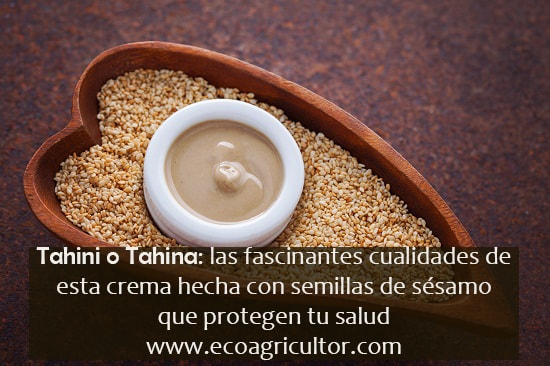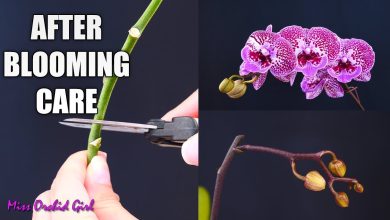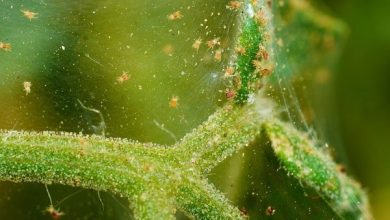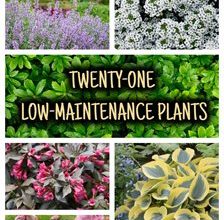Tahini or Tahina: benefits of its consumption and how to do it

Tahini has become, in its own right, a highly valued food due to its nutritional qualities and its beneficial effect on health.
In this post we tell you what this food is, its properties, how it is taken and we give you the recipe to prepare it at home. Also, at the end of the article I invite you to watch a video in which I summarize the most remarkable properties of tahini.
What is tahini or tahina?
The tahini, tahina or tahini , a paste made from sesame seeds or sesame seeds ( Sesamum indicum L.) found in various traditional Arabic cooking preparations, and now consumed in many countries worldwide.
Also known as butter or sesame or sesame paste , it is sold in jars ready for direct consumption. Its flavor is similar to nut butters or creams.
Sesame or sesame is currently cultivated in many countries, requires relatively little specialization for its cultivation and in many countries it is produced almost exclusively for export.
Although it is mainly used in Arabic cuisine, it has an increasing presence in Western cuisine. The sesame oil or sesame seeds is 47% oleic acid and 39% linoleic acid, which makes it competitive with other vegetable oils. For its part, whole seeds are increasingly used in the production of bakery products.
Tahini, for its part, is becoming increasingly popular in Western gastronomy and can be used both in preparations and sauces, as well as directly as a spreadable cream.
Nutritional value of tahini
Although it will depend on the ingredients and proportions used in its preparation, in general it is a very nutritious preparation that maintains all the beneficial properties of sesame or sesame.
It provides unsaturated fats (around 50%) such as lecithin –it has more than soy-, iron, calcium, zinc, phosphorus, magnesium and it contains a high quantity of vegetable proteins , in particular methionine.
The main active ingredient in sesame is sesamin . But in addition, sesame or sesame seeds have a natural antioxidant called sesamol (a lignan) that provide stability to tahini and it remains naturally for a long time.
It provides a good amount of calories, around 600 per 100 grams, however, being healthy components made cold and without additives, it is widely used as a substitute for butter or margarines.
Benefits of tahin consumption
This pasta made from sesame seeds provides great benefits to our health:
It exerts protective action on the liver and kidneys.
Sesamin has been shown to have anticancer action (due to its antiproliferative, anti-inflammatory, antimetastatic and pro-apoptotic effect on tumor cells) and to be a coadjuvant food in prevention and treatment.

It fights the breakdown of collagen and elastin in blood vessels, being effective in fighting abdominal aortic aneurysm.
The anti-inflammatory capacity of tahina makes it especially useful for cases of arthritis .
Tahini is a food that promotes digestion and stimulates the burning of fats . In particular, it stimulates the burning of brown fatty tissue or brown adipose tissue, which is mainly found in the chest and abdomen.
This delicious cream helps prevent the accumulation of cholesterol in the arteries .
Sesamin has been used as an agent to protect against brain injury.
Tahina helps protect bones against osteoporosis .
It has antioxidants, very important components that participate in a multitude of functions that are carried out in our body and protect health.
Sesamol has anti-inflammatory and regulatory capacity for the immune system .
The fibers and essential oils help to restore the natural motility of the intestine avoiding constipation or constipation.
The iron content makes it a recommended product for recovery from iron deficiency anemia and for the key stages of pregnancy and menopause.
Lectin, for its part, is recognized as useful for controlling cholesterol , although it is important to know the ingredients to achieve the emulsion, since it can also provide unsaturated fats (if sunflower, corn, soybean or other oils are used seeds) or monounsaturated (if olive oil is used).
Likewise, the preparations can incorporate different proportions of salt and sugar, so it is recommended to consult the content according to the specific diet.
Something of particular note is that it can cause allergy, for example, to people allergic to nuts .
.
How to take tahini
Tahini or tahina is used in traditional preparations of Arab cuisine such as hummus (chickpea puree) and baba ganush (aubergine puree), and is used as a sauce, diluted with lemon juice by adding garlic, for example for the falafel (chickpea or broad bean croquettes) , shawarma (roast meat), pinchos morunos (meat skewers) or in salads as part of the dressing.
It is also consumed as a kind of pate, spreading it on bread, on toast or pita bread (traditional Arabic). In some countries it is mixed with sweet preparations or syrup and is used mainly for breakfast , since it is a very energetic food.
It aligns very well with the preferences of the vegetarian diet and has been quickly incorporated into Western diets thanks to the fact that it is a gluten-free, dairy-free food that can also be free of sugar and salt, with high energy value and that it is easy to incorporate into different preparations, use it as a sauce for different dishes or take it directly as a substitute for butter or other spreads.
Making tahani at home, a simple recipe
To make the tahini paste or butter, you first have to toast the seeds, clean and free of any impurities, over low heat for about 5 minutes or until they are toasted. Ideally, do it in a frying pan and move it around to prevent them from burning (and lose nutrients) and to toast them on all sides.
Once golden, they are immersed in water until the shell is loose and, removing only the seeds, these are put in a mill or blender. Liquid, oil or water is added to it; It should be done with oil if it is going to be kept for spreading and with water to make it lighter or if it is going to be incorporated into another preparation.
Roasting them is an important step, as it helps to eliminate any bacteria. However, seeds are marketed: black sesame may not take too long to roast; golden sesame, usually whole or complete, if it requires roasting as it has not been refined; and the white sesame, it would not need roasting since it is already devoid of the external part.
Once in the blender or grinder it requires a bit of patience since the pasta will stick to the walls and you will have to help with a spatula so that the pasta is well crushed and homogeneous. The more crushed the seeds are, the better, but you can stop the process when you achieve the pleasant texture that you want to spread or add to the preparation.
Another option to make tahin at home is to buy an ECOLOGICAL TAHINI , more comfortable and simple to use.
Bibliographical sources:
- https://www.ncbi.nlm.nih.gov/pubmed/29032105
- “Regional standard for Tahina”, Codex Stan 259-R – 2007. FAO
- https://www.ncbi.nlm.nih.gov/pubmed/29992108
- «Production of tahini based on sesame (Sesamun indicum) of the Nicarao variety from the Juan Francisco Paz Silva company located in the Achuapa municipality», Ericka María Juárez and Walquiria Vannesa López. School of Food Engineering, Faculty of Chemical Sciences, National Autonomous University of Nicaragua. 2010.
- https://www.ncbi.nlm.nih.gov/pubmed/28784087
- https://www.ncbi.nlm.nih.gov/pubmed/30415772
- “Badra: Lebanese fast good and drinks”, Javier Alejandro Farraye Masri and Valeria María Crespo Cuesta. College of Hospitality, Culinary Arts and Tourism, Universidad San Francisco de Quito. 2015.
- https://www.ncbi.nlm.nih.gov/pubmed/30606956
- «Tahini, a Little Known Sesame- Containing Food, as an Unexpected Cause of Severe Allergic Reaction», L. Caminiti, D. Vita, G. Passalacqua, T. Arrigo, S. Barberi, F. Lombardo and GB. Pajano. Case Study. Department of Pediatrics, Allergy Unit, University of Messina, Italy. J. Investigating Allergol clin Immunol 2006.
- https://www.ncbi.nlm.nih.gov/pubmed/30788333




